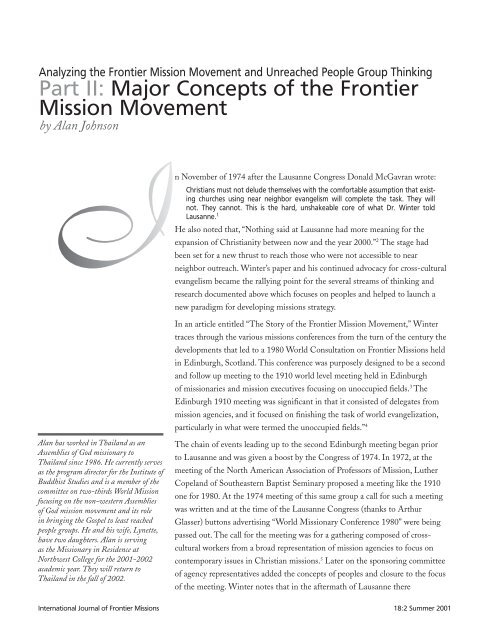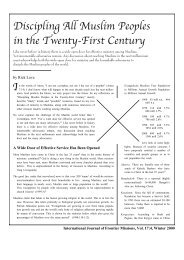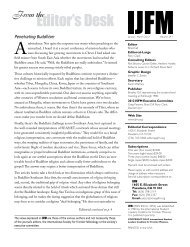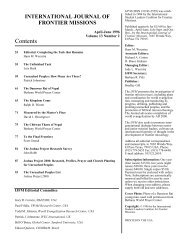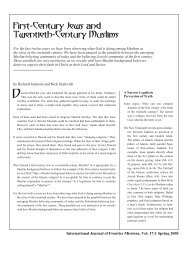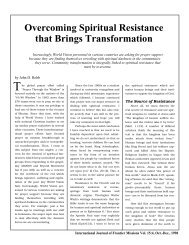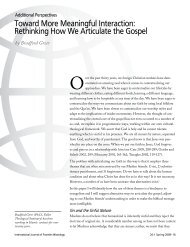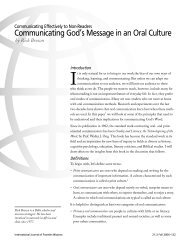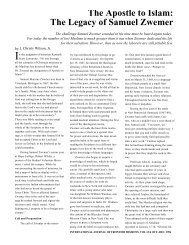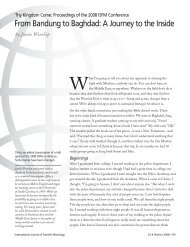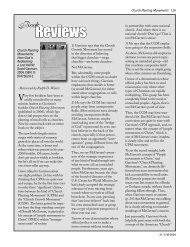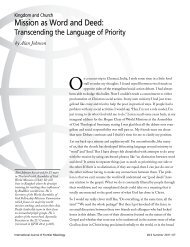Major Concepts of the Frontier Mission Movement - International ...
Major Concepts of the Frontier Mission Movement - International ...
Major Concepts of the Frontier Mission Movement - International ...
Create successful ePaper yourself
Turn your PDF publications into a flip-book with our unique Google optimized e-Paper software.
Analyzing <strong>the</strong> <strong>Frontier</strong> <strong>Mission</strong> <strong>Movement</strong> and Unreached People Group Thinking<br />
Part II: <strong>Major</strong> <strong>Concepts</strong> <strong>of</strong> <strong>the</strong> <strong>Frontier</strong><br />
<strong>Mission</strong> <strong>Movement</strong><br />
by Alan Johnson<br />
I<br />
Alan has worked in Thailand as an<br />
Assemblies <strong>of</strong> God missionary to<br />
Thailand since 1986. He currently serves<br />
as <strong>the</strong> program director for <strong>the</strong> Institute <strong>of</strong><br />
Buddhist Studies and is a member <strong>of</strong> <strong>the</strong><br />
committee on two-thirds World <strong>Mission</strong><br />
focusing on <strong>the</strong> non-western Assemblies<br />
<strong>of</strong> God mission movement and its role<br />
in bringing <strong>the</strong> Gospel to least reached<br />
people groups. He and his wife, Lynette,<br />
have two daughters. Alan is serving<br />
as <strong>the</strong> <strong>Mission</strong>ary in Residence at<br />
Northwest College for <strong>the</strong> 2001-2002<br />
academic year. They will return to<br />
Thailand in <strong>the</strong> fall <strong>of</strong> 2002.<br />
n November <strong>of</strong> 1974 after <strong>the</strong> Lausanne Congress Donald McGavran wrote:<br />
Christians must not delude <strong>the</strong>mselves with <strong>the</strong> comfortable assumption that existing<br />
churches using near neighbor evangelism will complete <strong>the</strong> task. They will<br />
not. They cannot. This is <strong>the</strong> hard, unshakeable core <strong>of</strong> what Dr. Winter told<br />
Lausanne. 1<br />
He also noted that, “Nothing said at Lausanne had more meaning for <strong>the</strong><br />
expansion <strong>of</strong> Christianity between now and <strong>the</strong> year 2000.” 2 The stage had<br />
been set for a new thrust to reach those who were not accessible to near<br />
neighbor outreach. Winter’s paper and his continued advocacy for cross-cultural<br />
evangelism became <strong>the</strong> rallying point for <strong>the</strong> several streams <strong>of</strong> thinking and<br />
research documented above which focuses on peoples and helped to launch a<br />
new paradigm for developing missions strategy.<br />
In an article entitled “The Story <strong>of</strong> <strong>the</strong> <strong>Frontier</strong> <strong>Mission</strong> <strong>Movement</strong>,” Winter<br />
traces through <strong>the</strong> various missions conferences from <strong>the</strong> turn <strong>of</strong> <strong>the</strong> century <strong>the</strong><br />
developments that led to a 1980 World Consultation on <strong>Frontier</strong> <strong>Mission</strong>s held<br />
in Edinburgh, Scotland. This conference was purposely designed to be a second<br />
and follow up meeting to <strong>the</strong> 1910 world level meeting held in Edinburgh<br />
<strong>of</strong> missionaries and mission executives focusing on unoccupied fields. 3 The<br />
Edinburgh 1910 meeting was significant in that it consisted <strong>of</strong> delegates from<br />
mission agencies, and it focused on finishing <strong>the</strong> task <strong>of</strong> world evangelization,<br />
particularly in what were termed <strong>the</strong> unoccupied fields.” 4<br />
The chain <strong>of</strong> events leading up to <strong>the</strong> second Edinburgh meeting began prior<br />
to Lausanne and was given a boost by <strong>the</strong> Congress <strong>of</strong> 1974. In 1972, at <strong>the</strong><br />
meeting <strong>of</strong> <strong>the</strong> North American Association <strong>of</strong> Pr<strong>of</strong>essors <strong>of</strong> <strong>Mission</strong>, Lu<strong>the</strong>r<br />
Copeland <strong>of</strong> Sou<strong>the</strong>astern Baptist Seminary proposed a meeting like <strong>the</strong> 1910<br />
one for 1980. At <strong>the</strong> 1974 meeting <strong>of</strong> this same group a call for such a meeting<br />
was written and at <strong>the</strong> time <strong>of</strong> <strong>the</strong> Lausanne Congress (thanks to Arthur<br />
Glasser) buttons advertising “World <strong>Mission</strong>ary Conference 1980” were being<br />
passed out. The call for <strong>the</strong> meeting was for a ga<strong>the</strong>ring composed <strong>of</strong> crosscultural<br />
workers from a broad representation <strong>of</strong> mission agencies to focus on<br />
contemporary issues in Christian missions. 5 Later on <strong>the</strong> sponsoring committee<br />
<strong>of</strong> agency representatives added <strong>the</strong> concepts <strong>of</strong> peoples and closure to <strong>the</strong> focus<br />
<strong>of</strong> <strong>the</strong> meeting. Winter notes that in <strong>the</strong> aftermath <strong>of</strong> Lausanne <strong>the</strong>re<br />
<strong>International</strong> Journal <strong>of</strong> <strong>Frontier</strong> <strong>Mission</strong>s 18:2 Summer 2001
90 Analyzing <strong>the</strong> <strong>Frontier</strong> <strong>Mission</strong> <strong>Movement</strong> and Unreached People Thinking<br />
was some lobbying on <strong>the</strong> part <strong>of</strong> both<br />
<strong>the</strong> World Council <strong>of</strong> Churches and<br />
<strong>the</strong> Lausanne Committee to coordinate<br />
<strong>the</strong> 1980 meeting. 6 As it turned out <strong>the</strong><br />
World Council held a 1980 meeting<br />
in Melbourne, Lausanne had one in<br />
Pattaya and Edinburgh was forced to<br />
reschedule till November. At <strong>the</strong> suggestion<br />
<strong>of</strong> <strong>the</strong> Lausanne Committee it<br />
also changed its name from “World<br />
<strong>Mission</strong>ary Conference” as it was<br />
in 1910 to “World Consultation on<br />
<strong>Frontier</strong> <strong>Mission</strong>s.”<br />
In August <strong>of</strong> 1979 <strong>the</strong> sponsoring committee<br />
<strong>of</strong> mission agencies voted:<br />
that those formally participating consist<br />
<strong>of</strong> delegates from agencies with<br />
current involvement in or with formal<br />
organizational commitment to reaching<br />
hidden people groups. 7<br />
Hidden peoples were defined as:<br />
those cultural and linguistic subgroups,<br />
urban or rural, for which <strong>the</strong>re is as yet<br />
no indigenous community <strong>of</strong> believing<br />
Christians able to evangelize <strong>the</strong>ir<br />
own people. 8<br />
The Edinburgh 1980 meeting thus<br />
became <strong>the</strong> crystallization point for this<br />
new movement by bringing to <strong>the</strong> front<br />
<strong>the</strong> idea <strong>of</strong> frontier missions and a<br />
people group focus. In <strong>the</strong> next section<br />
I will utilize material from <strong>the</strong> consultation<br />
and more recent writings to<br />
develop <strong>the</strong> critical definitions and concepts<br />
<strong>of</strong> frontier missions and <strong>the</strong>n trace<br />
<strong>the</strong>ir development down to <strong>the</strong> present.<br />
Definitions and <strong>Concepts</strong><br />
Defining frontier missions<br />
The plea <strong>of</strong> Winter’s 1974 Lausanne<br />
paper was for cross-cultural evangelism.<br />
This plea was based on <strong>the</strong> reality<br />
that although existing Christians and<br />
congregations do near neighbor evangelism<br />
well, <strong>the</strong>re are cultural barriers<br />
both on <strong>the</strong> side <strong>of</strong> <strong>the</strong> evangelist<br />
and <strong>the</strong> non-Christian. These barriers<br />
mean that for all practical purposes<br />
those who are not near neighbors <strong>of</strong><br />
<strong>the</strong> same culture will not be able to<br />
gain an adequate hearing <strong>of</strong> <strong>the</strong> gospel.<br />
Winter quotes Arthur Glasser’s summary<br />
<strong>of</strong> <strong>the</strong> situation as this:<br />
If every congregation in <strong>the</strong> world<br />
were to undergo a great revival and<br />
reach out to every person within <strong>the</strong>ir<br />
own people—that is, to everyone in <strong>the</strong><br />
cultural spheres represented by each<br />
congregation—over half <strong>of</strong> all remaining<br />
non-Christians would still not be<br />
reached. 9<br />
However, because <strong>of</strong> <strong>the</strong> fact that<br />
<strong>the</strong> terms “mission” and “missionary”<br />
were used in different ways that were<br />
firmly entrenched, Winter found it necessary<br />
in his advocating for cross-cultural<br />
evangelism to develop a new set <strong>of</strong><br />
terms to help bring clarification to <strong>the</strong><br />
issues. The key ideas can be found in<br />
his definition <strong>of</strong> frontier missions which<br />
“is <strong>the</strong> activity intended to accomplish<br />
<strong>the</strong> Pauline kind <strong>of</strong> missiological breakthrough<br />
to a Hidden People Group.” 10 I<br />
will expand each one <strong>of</strong> <strong>the</strong> major terms<br />
here and give some indication <strong>of</strong> <strong>the</strong>ir<br />
development after 1980.<br />
A distinction between frontier and<br />
regular missions<br />
The frontier mission movement was<br />
distinguished by <strong>the</strong> fact that it adds<br />
<strong>the</strong> adjective “frontier” to missions to<br />
separate this activity from what it<br />
calls “regular” missions. It is important<br />
to understand that <strong>the</strong>se terms were<br />
adopted in order to bring a sense <strong>of</strong><br />
precision about <strong>the</strong> remaining task <strong>of</strong><br />
<strong>the</strong> Great Commission and how to<br />
complete it. They reflect an understanding<br />
<strong>of</strong> missiological reality where <strong>the</strong><br />
Church has reached virtually all geopolitical<br />
nation states and where many<br />
countries <strong>of</strong> <strong>the</strong> world have thriving<br />
Christian movements. As was noted<br />
in <strong>the</strong> historical review and <strong>the</strong><br />
summary <strong>of</strong> Winter’s 1974 paper,<br />
unreached people group thinking specifically<br />
defines a missionary as one who<br />
crosses a cultural boundary to share<br />
<strong>the</strong> gospel where no indigenous church<br />
exists. What Winter strives to point<br />
out is that in <strong>the</strong> missiological reality<br />
<strong>of</strong> today, most “missionaries” in this<br />
narrow sense who are crossing real cultural<br />
boundaries do so in order to<br />
work among a culture where <strong>the</strong>re is<br />
an already existing church movement <strong>of</strong><br />
some sort. This he terms “regular” missions,<br />
11 which is involved in all kinds<br />
<strong>of</strong> good work assisting national church<br />
movements, doing works <strong>of</strong> compassion,<br />
training leaders and discipling new<br />
believers. The term “frontier” is <strong>the</strong>n<br />
reserved for ano<strong>the</strong>r kind <strong>of</strong> cross-cultural<br />
work, <strong>the</strong> kind where <strong>the</strong>re is<br />
no existing church movement among a<br />
particular people. As seen in <strong>the</strong> definition<br />
above, <strong>the</strong> condition <strong>of</strong> frontier<br />
missions depends upon two things: <strong>the</strong><br />
need for 1) a missiological breakthrough<br />
2) among a people that is “hidden.” The<br />
idea <strong>of</strong> “hidden” here means that <strong>the</strong><br />
group does not have a strong enough<br />
Christian movement resident that can<br />
do near neighbor evangelism and thus<br />
requires a cross-cultural missionary to<br />
come and share <strong>the</strong> gospel.<br />
Defining missiological breakthrough<br />
Missiological breakthrough is <strong>the</strong> process:<br />
whereby a church in a new tradition is<br />
born within <strong>the</strong> indigenous culture (not<br />
borrowed and patched in from ano<strong>the</strong>r<br />
country or cultural tradition) . . . . Such<br />
a breakthrough classically was Paul’s<br />
concern, that is, to produce a truly<br />
Gentile synagogue. 12<br />
The goal <strong>of</strong> such a breakthrough is a<br />
viable church, which is a concept very<br />
important to <strong>the</strong> missiology and strategy<br />
<strong>of</strong> <strong>the</strong> frontier mission movement.<br />
Winter notes that <strong>the</strong> viable church is:<br />
. . . not just anything someone may call<br />
a church, and this emphasis <strong>the</strong>n corresponds<br />
to <strong>the</strong> previous statement:<br />
at least that minimum yet sufficiently<br />
developed indigenous Christian tradition<br />
to be capable <strong>of</strong> evangelizing its<br />
own people without E2 or E3 help. A<br />
barely viable church must be understood<br />
as a minimal goal. Nothing here<br />
should imply that any such church anywhere<br />
should be considered totally<br />
independent <strong>of</strong> <strong>the</strong> world family <strong>of</strong><br />
Christians, nor that it cannot both<br />
minister through and pr<strong>of</strong>it from<br />
continued cross-cultural contacts and<br />
expatriate help. All it means is that <strong>the</strong><br />
missiological breakthrough has been<br />
made. This would seem to require at<br />
least a cluster <strong>of</strong> indigenous evangelizing<br />
congregations and a significant<br />
part <strong>of</strong> <strong>the</strong> Bible translated by <strong>the</strong><br />
people <strong>the</strong>mselves. 13<br />
It is important to understand at this<br />
point that <strong>the</strong>se definitions are human<br />
constructs designed to help us create<br />
a tangible form <strong>of</strong> measurement for<br />
describing basic aspects <strong>of</strong> <strong>the</strong> completion<br />
<strong>of</strong> <strong>the</strong> Great Commission. Jesus<br />
said to make disciples among every<br />
ethne, so <strong>the</strong> concept <strong>of</strong> missiological<br />
breakthrough defines in a minimal sense<br />
what it would mean to bring <strong>the</strong> gospel<br />
to a group <strong>of</strong> people that previously<br />
had no Christians at all. It is significant<br />
to note that <strong>the</strong> task here focuses not<br />
<strong>International</strong> Journal <strong>of</strong> <strong>Frontier</strong> <strong>Mission</strong>s
Part II: <strong>Major</strong> <strong>Concepts</strong> <strong>of</strong> <strong>the</strong> <strong>Frontier</strong> <strong>Mission</strong> <strong>Movement</strong><br />
91<br />
These are precisely <strong>the</strong> type <strong>of</strong> groups and situations where existing churches<br />
manifest “people blindness,” being unable to see past <strong>the</strong>ir own cultural walls<br />
and prejudices in order to reach out to a group that is different than <strong>the</strong>m.<br />
on simply telling people <strong>the</strong> gospel, nor<br />
planting a single church, but ra<strong>the</strong>r it is<br />
to seek to develop an indigenous movement<br />
<strong>of</strong> churches that are capable <strong>of</strong><br />
doing <strong>the</strong> work <strong>of</strong> near neighbor evangelism<br />
without outside help. It is not so<br />
much an issue <strong>of</strong> <strong>the</strong> size or percentage<br />
<strong>of</strong> believers as one <strong>of</strong> vitality <strong>of</strong> that<br />
Christian movement.<br />
Defining hidden peoples<br />
The second component <strong>of</strong> <strong>the</strong> definition<br />
<strong>of</strong> frontier missions has to do with a<br />
people group, particularly a group that<br />
Winter defined as “hidden.” At this<br />
point Winter introduces ano<strong>the</strong>r continuum<br />
to help illustrate his point. This<br />
continuum parallels <strong>the</strong> one on evangelism<br />
with its E-0 to E-3 distinctions <strong>of</strong><br />
cultural distance from <strong>the</strong> hearer, except<br />
that it looks at how far <strong>the</strong> individuals<br />
in a people group are culturally from<br />
a church movement. Thus P-0 to P-3<br />
refers to individuals in people groups<br />
that are ei<strong>the</strong>r very similar to that <strong>of</strong> <strong>the</strong><br />
evangelist (P-0 meaning nominal and<br />
not born again, P-.5 meaning those on<br />
<strong>the</strong> fringe <strong>of</strong> <strong>the</strong> church but having a<br />
church within <strong>the</strong>ir people, P-1 referring<br />
to those who do not identify<br />
<strong>the</strong>mselves as Christians but have an<br />
indigenous evangelizing church within<br />
<strong>the</strong>ir group) or who are increasingly dissimilar<br />
(P-2 and P-2.5) or who do not<br />
have any Christian movement close to<br />
<strong>the</strong>m culturally (P-3). 14<br />
The critical missiological point that<br />
Winter strives to make here is that<br />
even though <strong>the</strong>re are many missionaries<br />
crossing E-2 and E-3 boundaries,<br />
<strong>the</strong>y are most <strong>of</strong>ten doing so to work<br />
among a people that is P-1, meaning<br />
that <strong>the</strong>y have an evangelizing church<br />
within <strong>the</strong>ir own cultural group. He<br />
points out that when <strong>the</strong> E number is<br />
larger than <strong>the</strong> P number “<strong>the</strong>re is an<br />
inherent waste <strong>of</strong> effort, even though for<br />
o<strong>the</strong>r purposes such activity may be justified.”<br />
15 Thus “regular” missions takes<br />
place when cross-cultural missionaries<br />
work among a people that already can<br />
do near-neighbor evangelism. As a missionary,<br />
it is E-2 or E-3 work for <strong>the</strong>m,<br />
but to <strong>the</strong> local people it is an E-1 situation.<br />
Winter is not denigrating such<br />
work, which has importance in leadership<br />
training and in fact development<br />
<strong>of</strong> fur<strong>the</strong>r missionary activity from that<br />
group to o<strong>the</strong>r groups. Ra<strong>the</strong>r, he is<br />
pleading for <strong>the</strong> necessity <strong>of</strong> an expansion<br />
<strong>of</strong> work by E-2 and E-3 missionaries<br />
among P-2 and P-3 groups,<br />
which is <strong>the</strong> special and complex work<br />
<strong>of</strong> missiological breakthrough and what<br />
he terms true “frontier” missions. These<br />
P-2 and P-3 groups are “hidden”<br />
because <strong>the</strong>re is no church culturally<br />
close enough to reach out to <strong>the</strong>m<br />
and <strong>the</strong>y require a cross-cultural effort.<br />
These are precisely <strong>the</strong> type <strong>of</strong> groups<br />
and situations where existing churches<br />
manifest “people blindness,” being<br />
unable to see past <strong>the</strong>ir own cultural<br />
walls and prejudices in order to reach<br />
out to a group that is different than<br />
<strong>the</strong>m.<br />
Developments in Key <strong>Concepts</strong><br />
The whole idea <strong>of</strong> frontier missions is<br />
driven by <strong>the</strong> concepts <strong>of</strong> peoples and<br />
<strong>the</strong> need to have missiological breakthrough<br />
to produce a viable church.<br />
This next section will examine <strong>the</strong>se<br />
two interrelated concepts as <strong>the</strong>y have<br />
been refined and debated over <strong>the</strong> past<br />
20 years. The critical issues concern<br />
<strong>the</strong> definition <strong>of</strong> a people group, how<br />
to define whe<strong>the</strong>r a people has been<br />
reached or not with missiological breakthrough,<br />
and how many unreached<br />
groups actually remain.<br />
Defining people groups<br />
The Lausanne Strategy Working Group<br />
initially defined a people group as “a<br />
significantly large sociological grouping<br />
<strong>of</strong> individuals who perceive <strong>the</strong>mselves<br />
to have a common affinity for one<br />
ano<strong>the</strong>r.” 16 In order to bring fur<strong>the</strong>r<br />
clarity to <strong>the</strong> idea a meeting was<br />
jointly convened March 25–26, 1982 in<br />
Chicago by <strong>the</strong> Lausanne Committee<br />
and <strong>the</strong> EFMA in order to help<br />
settle a standardized terminology. A<br />
number <strong>of</strong> mission agencies and organizations<br />
involved in people group<br />
research attended. They agreed on <strong>the</strong><br />
following definition:<br />
A people group is a significantly<br />
large sociological grouping <strong>of</strong> individuals<br />
who perceive <strong>the</strong>mselves to have<br />
a common affinity for one ano<strong>the</strong>r<br />
because <strong>of</strong> <strong>the</strong>ir shared language, religion,<br />
ethnicity, residence, occupation,<br />
class or caste, situation etc. or combinations<br />
<strong>of</strong> <strong>the</strong>se. From <strong>the</strong> viewpoint<br />
<strong>of</strong> evangelization this is <strong>the</strong> largest<br />
possible group within which <strong>the</strong> gospel<br />
can spread as a viable, indigenous<br />
church planting movement without<br />
encountering barriers <strong>of</strong> understanding<br />
or acceptance. 17<br />
Johnstone notes several variations from<br />
<strong>the</strong> original definition have been suggested.<br />
18 It was Ralph Winter who<br />
argued for <strong>the</strong> addition <strong>of</strong> <strong>the</strong> terms<br />
“viable, indigenous” in <strong>the</strong> definition<br />
while Barbara Grimes felt that <strong>the</strong><br />
words “significantly large” were dangerous<br />
because it may cause people to overlook<br />
small language groups. Later in<br />
that same year <strong>the</strong> Lausanne Strategy<br />
Working Committee dropped <strong>the</strong> phrase<br />
“as a viable, indigenous church planting<br />
movement” so that <strong>the</strong> idea <strong>of</strong> sociological<br />
groups could be added to <strong>the</strong> concept.<br />
Johnstone suggests that within <strong>the</strong><br />
varieties <strong>of</strong> this definition <strong>the</strong>re were two<br />
fundamental perspectives operating, that<br />
<strong>of</strong> ethnolinguistic peoples and sociological<br />
people groups. 19<br />
This uncertainty as to whe<strong>the</strong>r or not to<br />
count sociological groups as candidates<br />
for church planting (such as prisoners,<br />
taxi drivers, drug addicts, etc.) along<br />
with ethnolinguistic groups has been at<br />
<strong>the</strong> heart <strong>of</strong> <strong>the</strong> controversy over how<br />
many unreached groups actually remain.<br />
Johnstone suggests that one solution<br />
is to use <strong>the</strong> broad umbrella term<br />
people groups as defined above and<br />
<strong>the</strong>n prefix o<strong>the</strong>r terms to indicate<br />
18:2 Summer 2001
92 Analyzing <strong>the</strong> <strong>Frontier</strong> <strong>Mission</strong> <strong>Movement</strong> and Unreached People Thinking<br />
<strong>the</strong> parameters in terms <strong>of</strong> evangelistic<br />
work. 20 Ethnolinguistic peoples are <strong>the</strong>n<br />
<strong>the</strong> concern <strong>of</strong> cross-cultural church<br />
planters and can be more easily counted,<br />
sociopeoples can be <strong>the</strong> target <strong>of</strong> ei<strong>the</strong>r<br />
cross-cultural agencies or a local church<br />
depending on <strong>the</strong> situation, since some<br />
sociopeoples may require an outside<br />
cross-cultural church planting effort.<br />
Sociopeoples are <strong>the</strong> concerns <strong>of</strong> local<br />
churches and specialized ministries to<br />
reach out to sociological groupings that<br />
do not need a separate church planting<br />
movement but need to hear <strong>the</strong> gospel.<br />
These last two groups are very difficult<br />
to count and <strong>the</strong>re are huge numbers <strong>of</strong><br />
<strong>the</strong>m as well.<br />
Most recently <strong>the</strong> efforts to quantify<br />
<strong>the</strong> remaining task <strong>of</strong> people groups in<br />
need <strong>of</strong> missiological breakthrough has<br />
led to an approach which merged four<br />
major streams <strong>of</strong> people group research<br />
to count those ethnolinguistic peoples<br />
appearing on all four lists and taking<br />
into account political boundaries. 21 This<br />
list, known as <strong>the</strong> Joshua 2000 Project<br />
( JP 2000) list was developed for people<br />
groups with over 10,000 members and<br />
originally featured 1685 groups which<br />
had less than 2% Evangelicals and<br />
5% total Christian adherents. As <strong>of</strong><br />
December 1999 <strong>the</strong>re were 1594 peoples,<br />
1117 <strong>of</strong> which had no church<br />
reported, 539 with no known church<br />
planting team on site, and 197 peoples<br />
unchosen. 22<br />
Defining unreached and reached<br />
This leads us to a discussion <strong>of</strong> <strong>the</strong><br />
concepts unreached and reached when<br />
speaking <strong>of</strong> a people group. By <strong>the</strong><br />
1982 definition an unreached people<br />
group is a:<br />
people or people group among which<br />
<strong>the</strong>re is no indigenous community<br />
<strong>of</strong> believing Christians with adequate<br />
numbers and resources to evangelize<br />
<strong>the</strong> rest <strong>of</strong> its members without outside<br />
(cross-cultural) assistance. 23<br />
A reached people group <strong>the</strong>n is:<br />
A people group with adequate indigenous<br />
believers and resources to<br />
evangelize this group without outside<br />
(cross-cultural) assistance. 24<br />
The difficulties in quantifying <strong>the</strong><br />
number <strong>of</strong> unreached people groups has<br />
come not only in <strong>the</strong> way in which a<br />
people is defined, but also in trying to<br />
determine by <strong>the</strong>se definitions when a<br />
group is actually reached.<br />
In <strong>the</strong> early stages <strong>the</strong> Lausanne<br />
Committee Strategy Working Group<br />
defined an unreached group as one in<br />
which <strong>the</strong>re less than 20% practicing<br />
Christians. 25 This number was chosen<br />
because sociological diffusion <strong>of</strong> innovation<br />
<strong>the</strong>ory indicated that “when an<br />
innovation is proposed to a given society,<br />
<strong>the</strong> ‘early adapters’ will constitute<br />
somewhere between ten and twenty<br />
percent <strong>of</strong> <strong>the</strong> people. Until <strong>the</strong>y adopt<br />
it <strong>the</strong> innovation spreads very slowly.” 26<br />
Hesselgrave says that it was predictable<br />
that such a definition would produce<br />
criticism. 27 There were two primary<br />
objections to <strong>the</strong> use <strong>of</strong> 20% benchmark.<br />
First, it meant that even places<br />
in <strong>the</strong> world where some <strong>of</strong> <strong>the</strong> most<br />
successful evangelism had occurred (like<br />
South Korea) would not be considered<br />
reached. Second, <strong>the</strong> definition said<br />
nothing about <strong>the</strong> state <strong>of</strong> <strong>the</strong> churches<br />
in such a culture and <strong>the</strong>ir ability to<br />
proclaim <strong>the</strong> gospel. 28 Later it was proposed<br />
that <strong>the</strong>re could be a breakdown<br />
<strong>of</strong> this percentage so that 0–1% represented<br />
initially reached, 1–10% minimally<br />
reached and 10–20% possibly<br />
reached. 29<br />
It was at this same 1982 meeting that an<br />
agreement was reached whereby <strong>the</strong> U.<br />
S. Center for World <strong>Mission</strong> would give<br />
up using its phrase “Hidden Peoples”<br />
and adopt <strong>the</strong> Lausanne Strategy<br />
Working Group’s phrase “Unreached<br />
Peoples” on <strong>the</strong> grounds that <strong>the</strong><br />
latter’s percentage definitions would be<br />
replaced by <strong>the</strong> USCWM’s definition<br />
based simply on <strong>the</strong> presence or absence<br />
<strong>of</strong> a viable indigenous evangelizing<br />
church movement.<br />
Ano<strong>the</strong>r approach in trying to quantify<br />
reachedness has been that <strong>of</strong> David<br />
Barrett in <strong>the</strong> World Christian<br />
Encyclopedia. He uses “reached” and<br />
“evangelized” synonymously and<br />
“defined both in terms <strong>of</strong> <strong>the</strong> state <strong>of</strong><br />
having had <strong>the</strong> gospel made available or<br />
<strong>of</strong>fered to a person or people.” 30 In his<br />
efforts to chart out missiological reality<br />
Barrett has divided <strong>the</strong> world into what<br />
he calls Worlds A, B, and C. World C<br />
is evangelized and primarily Christian,<br />
world A is <strong>the</strong> unevangelized and non-<br />
Christian, while world B is <strong>the</strong> evangelized<br />
non-Christian. By this term he<br />
means those who are not Christians<br />
but who are aware <strong>of</strong> Christianity,<br />
Christ and <strong>the</strong> gospel but have not<br />
yet responded positively. 31 As with <strong>the</strong><br />
o<strong>the</strong>r sociological definition, this has<br />
not been very satisfying as well since<br />
it appears to leave such a huge part <strong>of</strong><br />
<strong>the</strong> non-Christian world as a lesser strategic<br />
target since it is already “evangelized”<br />
in this very narrow sense. In a<br />
1993 article in <strong>Mission</strong> <strong>Frontier</strong>s Bulletin<br />
Frank Kaleb Jansen points out that in<br />
a broad sense, Barrett’s use <strong>of</strong> <strong>the</strong> term<br />
“evangelized” is seeking primarily to<br />
measure exposure to <strong>the</strong> gospel, while<br />
<strong>the</strong> idea <strong>of</strong> “unreached” focuses on<br />
response. It is a comparison <strong>of</strong> apples<br />
and oranges. 32 A more recent trend<br />
has been to move away from a percentage<br />
viewpoint to consider a whole<br />
complex <strong>of</strong> factors that would indicate<br />
unreachedness and in its opposite state,<br />
reachedness. Five criterion have been<br />
proposed as constituting an unreached<br />
group: 33<br />
1. The people have not heard <strong>the</strong><br />
gospel in an understandable way or<br />
form.<br />
2. The people group has not<br />
responded to <strong>the</strong> gospel.<br />
3. The people group has no growing<br />
church or fellowship <strong>of</strong> believers.<br />
4. The Word <strong>of</strong> God has not been<br />
translated in <strong>the</strong> mo<strong>the</strong>r tongue <strong>of</strong><br />
<strong>the</strong> people.<br />
5. The Word <strong>of</strong> God is not available<br />
(due to illiteracy or legal restrictions<br />
<strong>of</strong> <strong>the</strong> country).<br />
In constructing <strong>the</strong> Joshua Project 2000<br />
list <strong>the</strong>se criteria along with <strong>the</strong> less<br />
than 2% evangelical and 5% total<br />
Christian adherents figures were what<br />
was used. In this sense <strong>the</strong>re has been<br />
a combination <strong>of</strong> <strong>the</strong> ideas <strong>of</strong> evangelizing<br />
by having <strong>the</strong> gospel <strong>of</strong>fered or<br />
accessible in some form, a percentage <strong>of</strong><br />
response, and <strong>the</strong> idea <strong>of</strong> <strong>the</strong>re being<br />
a relevant communication <strong>of</strong> <strong>the</strong> gospel<br />
and opportunity for response.<br />
Just how ambiguous and confusing <strong>the</strong><br />
concepts <strong>of</strong> unreached and reached<br />
people groups have become is seen in<br />
a 1990 Evangelical <strong>Mission</strong>s Quarterly<br />
survey <strong>of</strong> mission leaders on what<br />
“reached” means. 34 There is very little<br />
agreement among <strong>the</strong> eight respondents,<br />
it depends primarily on <strong>the</strong> type<br />
<strong>of</strong> effort that <strong>the</strong>y are involved in.<br />
Those involved in church planting type<br />
ministries tend to conceive <strong>of</strong> reached<br />
in terms <strong>of</strong> a viable church present<br />
<strong>International</strong> Journal <strong>of</strong> <strong>Frontier</strong> <strong>Mission</strong>s
Part II: <strong>Major</strong> <strong>Concepts</strong> <strong>of</strong> <strong>the</strong> <strong>Frontier</strong> <strong>Mission</strong> <strong>Movement</strong><br />
93<br />
in that people, while o<strong>the</strong>rs with ministries<br />
focusing more on evangelism tend<br />
toward a definition which speaks <strong>of</strong><br />
having given people <strong>the</strong> opportunity to<br />
hear and respond to <strong>the</strong> gospel.<br />
How many unreached people<br />
groups are <strong>the</strong>re?<br />
If <strong>the</strong> goal is to complete <strong>the</strong> Great<br />
Commission by planting a viable indigenous<br />
church among every people group<br />
in <strong>the</strong> world, how many unreached<br />
groups are <strong>the</strong>re? As I have pointed<br />
out above, <strong>the</strong> move towards people<br />
group research was already happening<br />
before <strong>the</strong> Lausanne Congress in 1974.<br />
However, it was Ralph Winter’s preliminary<br />
estimate <strong>of</strong> 16,750 unreached<br />
people groups that really began to spark<br />
<strong>the</strong> debate about <strong>the</strong> number <strong>of</strong> remaining<br />
peoples in <strong>the</strong> world. Johnstone<br />
says that although Winter’s challenge<br />
and <strong>the</strong> 16,750 group number “motivated<br />
many Christians, churches and<br />
agencies to do something for <strong>the</strong> forgotten<br />
peoples with no exposure to<br />
<strong>the</strong> gospel . . . because <strong>the</strong> definitions <strong>of</strong><br />
people, people group and unreached and<br />
hidden were not clear and consistent,<br />
considerable confusion resulted.” 35 The<br />
first problem was that back <strong>the</strong>n <strong>the</strong>re<br />
was no actual list <strong>of</strong> <strong>the</strong>se peoples, <strong>the</strong>y<br />
were estimates based on <strong>the</strong> sources<br />
<strong>of</strong> research available at that time.<br />
Johnstone notes that although it was<br />
a “wonderful mobilizing concept . . . frustration<br />
grew without <strong>the</strong> check-list <strong>of</strong><br />
peoples—how could <strong>the</strong>y become targeted<br />
and reached?” 36 The second problem,<br />
which I have alluded to above,<br />
is that researchers began to make<br />
<strong>the</strong>ir own definitions <strong>of</strong> people and<br />
unreached/reached based on <strong>the</strong> type<br />
<strong>of</strong> ministry <strong>the</strong>y were involved in, thus<br />
causing some to include sociological<br />
peoples while o<strong>the</strong>rs wanted to focus<br />
strictly on ethnolinguistic groups. 37<br />
Jaffarian, writing in 1994 documents<br />
some <strong>of</strong> <strong>the</strong> confusion that had occurred<br />
up to that time in trying to make<br />
estimates <strong>of</strong> <strong>the</strong> number <strong>of</strong> unreached<br />
people groups. 38 He points out that<br />
Winter’s first estimate <strong>of</strong> 16,750 was<br />
first changed up to 17,000 to show its<br />
imprecise character and <strong>the</strong>n in 1989<br />
after an agreement among researchers<br />
to look at larger segments was reached<br />
it was revised down to 12,000. Later<br />
it was dropped to 11,000 in 1991<br />
to show progress. Adopt-A-People<br />
Clearinghouse came up with a figure <strong>of</strong><br />
6,000 that was unconnected to <strong>the</strong> process<br />
used to determine <strong>the</strong> o<strong>the</strong>r lists.<br />
He concludes, “Those who produced<br />
<strong>the</strong> changed estimates are not claiming<br />
<strong>the</strong> changes are due to sudden progress.”<br />
39 The changes were due to <strong>the</strong><br />
methodology used in doing <strong>the</strong> counting<br />
ra<strong>the</strong>r than in verifiable statistical<br />
studies among <strong>the</strong>se groups.<br />
A more hopeful approach, noted above,<br />
was <strong>the</strong> work <strong>of</strong> <strong>the</strong> Joshua Project 2000<br />
list begun in 1995 that has brought<br />
toge<strong>the</strong>r four major streams <strong>of</strong> research<br />
in a cooperative effort in order to identify<br />
and prioritize least evangelized peoples.<br />
In a kind <strong>of</strong> disclaimer put out<br />
with <strong>the</strong> original list, Dan Scribner<br />
points out that it is not comprehensive,<br />
it contains only peoples that all <strong>the</strong><br />
streams <strong>of</strong> research agreed upon. He<br />
also notes <strong>the</strong>re are many errors that<br />
require feedback to be corrected, that<br />
<strong>the</strong> list is intended for annual revision,<br />
and is at best only a general picture<br />
<strong>of</strong> peoples most needing <strong>the</strong> gospel. 40<br />
Despite some <strong>of</strong> <strong>the</strong>se weaknesses and<br />
limitations it does bring a unifying force<br />
to people group research by drawing<br />
into one database <strong>the</strong> work <strong>of</strong> major<br />
research groups around agreed upon criteria.<br />
As such, it has <strong>the</strong> potential for<br />
being a powerful evaluative tool to track<br />
gospel penetration among <strong>the</strong> peoples<br />
on <strong>the</strong> list.<br />
In <strong>the</strong> final analysis one needs to go<br />
back to <strong>the</strong> 1982 definition <strong>of</strong> a people<br />
and remember that <strong>the</strong> definition is tied<br />
to a strategy for evangelism. The crucial<br />
phrase is that <strong>the</strong> gospel can spread as<br />
a church planting movement “without<br />
encountering barriers <strong>of</strong> understanding<br />
or acceptance.” With this understanding,<br />
it means that <strong>the</strong> task <strong>of</strong> making<br />
lists <strong>of</strong> <strong>the</strong> unreached is always a work<br />
in progress and never fully quantifiable<br />
because as <strong>the</strong> work <strong>of</strong> church planting<br />
proceeds among various ethnolinguistic<br />
and sociological groups new barriers<br />
previously unseen will be encountered.<br />
This means that new church planting<br />
efforts will need to be undertaken for<br />
this new group. The revisions <strong>of</strong> numbers<br />
<strong>of</strong> unreached people groups from<br />
over 16,000 down to several thousands<br />
down to <strong>the</strong> 1685 <strong>of</strong> <strong>the</strong> initial run <strong>of</strong><br />
<strong>the</strong> Joshua Project 2000 list reflect not<br />
only progress in <strong>the</strong> spread <strong>of</strong> <strong>the</strong> gospel<br />
but changes in methodology and criteria<br />
for counting. If it turns out that <strong>the</strong> JP<br />
2000 list becomes <strong>the</strong> standard measuring<br />
device it will necessarily fluctuate up<br />
and down as pioneering church planting<br />
efforts reveals ei<strong>the</strong>r <strong>the</strong> existence or<br />
non-existence <strong>of</strong> barriers to <strong>the</strong> spread<br />
<strong>of</strong> <strong>the</strong> gospel.<br />
<strong>Movement</strong>s, Organizations<br />
and Applications<br />
Ralph Winter’s 1974 paper on crosscultural<br />
evangelism was both a culmination<br />
and a beginning. His articulation<br />
<strong>of</strong> <strong>the</strong> need for cross-cultural evangelism<br />
was in a sense <strong>the</strong> culmination <strong>of</strong> many<br />
streams <strong>of</strong> thought that had been incubating<br />
in mission circles for a number<br />
<strong>of</strong> years. The platform <strong>of</strong> that presentation,<br />
<strong>the</strong> Lausanne Congress on World<br />
Evangelization, was itself evidence <strong>of</strong><br />
<strong>the</strong> growth <strong>of</strong> a broader movement<br />
focusing on <strong>the</strong> completion <strong>of</strong> <strong>the</strong> Great<br />
Commission. However, <strong>the</strong> very act<br />
<strong>of</strong> articulating those concepts in conjunction<br />
with <strong>the</strong> momentum towards<br />
world evangelization contained in <strong>the</strong><br />
Lausanne movement was <strong>the</strong> catalyst<br />
for <strong>the</strong> proliferation <strong>of</strong> a host <strong>of</strong><br />
new organizations. These sub-movements<br />
and organizations utilize and<br />
apply <strong>the</strong> missiological paradigms <strong>of</strong> <strong>the</strong><br />
frontier mission thinking. This section<br />
will examine some <strong>of</strong> <strong>the</strong> major move-<br />
However, it was Ralph Winter’s preliminary estimate <strong>of</strong> 16,750 unreached<br />
people groups that really began to spark <strong>the</strong> debate about <strong>the</strong> number <strong>of</strong><br />
remaining peoples in <strong>the</strong> world.<br />
18:2 Summer 2001
94 Analyzing <strong>the</strong> <strong>Frontier</strong> <strong>Mission</strong> <strong>Movement</strong> and Unreached People Thinking<br />
ments, organizations and applications <strong>of</strong><br />
frontier mission thinking that form part<br />
<strong>of</strong> <strong>the</strong> contemporary mission landscape<br />
today.<br />
Initial People Group Research<br />
Winter has chronicled events and meetings<br />
beginning with World War II<br />
through 1995 which he believes “evidences<br />
<strong>the</strong> growth <strong>of</strong> a significant historical<br />
movement . . . [<strong>the</strong>y are] events<br />
which reflect <strong>the</strong> exploding rebirth <strong>of</strong><br />
global vision.” 41 I will jump into this<br />
history in 1974 with <strong>the</strong> Lausanne<br />
Congress. As I noted above, <strong>the</strong><br />
Lausanne Congress was intended from<br />
<strong>the</strong> beginning to be an ongoing movement.<br />
Wagner says that <strong>the</strong> challenge<br />
given to reach <strong>the</strong> 3 billion who had<br />
never heard at <strong>the</strong> Congress “stimulated<br />
<strong>the</strong> 2,400 participants . . . to request <strong>the</strong><br />
formation <strong>of</strong> an ongoing structure to<br />
stimulate and practical implementation<br />
<strong>of</strong> <strong>the</strong> Lausanne vision for reaching<br />
<strong>the</strong> unreached.” 42 This happened in<br />
Mexico City, January 20–23, 1975,<br />
when <strong>the</strong> Lausanne Committee for<br />
World Evangelization was <strong>of</strong>ficially<br />
formed. Structurally, it consisted <strong>of</strong><br />
an international body, seven regional<br />
committees dealing with evangelistic<br />
challenges in <strong>the</strong>ir areas, an executive<br />
committee <strong>of</strong> twelve and four working<br />
groups: <strong>the</strong>ology and education, intercession,<br />
communication and strategy. 43<br />
What is important to our study here<br />
are <strong>the</strong> tasks assigned to <strong>the</strong> Strategy<br />
Working Group. They were to identify<br />
and describe unreached peoples, identify<br />
forces for evangelism and suggest<br />
effective methodologies for evangelism.<br />
This group from <strong>the</strong> beginning established<br />
a working relationship with<br />
<strong>Mission</strong> Advanced Research and<br />
Communication Center (MARC)<br />
which had been founded in 1966 specifically<br />
around <strong>the</strong> philosophy <strong>of</strong> evangelization<br />
based on people groups. 44<br />
MARC had been asked by <strong>the</strong> program<br />
committee <strong>of</strong> <strong>the</strong> Lausanne Congress to<br />
prepare statistical data on <strong>the</strong> current<br />
status <strong>of</strong> world evangelization, which<br />
led to <strong>the</strong>ir presentation <strong>of</strong> an Unreached<br />
Peoples Directory listing 434 peoples. 45<br />
In <strong>the</strong> years after <strong>the</strong> 1974 congress<br />
<strong>the</strong> Strategy Working Group used<br />
<strong>the</strong> research capabilities <strong>of</strong> MARC to<br />
help produce “a series <strong>of</strong> publications<br />
that focused on unreached peoples and<br />
developing strategies to reach <strong>the</strong>m. 46<br />
The series Unreached Peoples ran from<br />
1979–1987 and included strategic articles<br />
and a particular focus as well as<br />
broad lists <strong>of</strong> unreached groups.<br />
The U.S. Center for World <strong>Mission</strong><br />
In 1976 Ralph Winter presented<br />
a paper entitled “The Grounds for<br />
a New Thrust in World <strong>Mission</strong>”<br />
to <strong>the</strong> Executives Retreat <strong>of</strong> <strong>the</strong><br />
Interdenominational Foreign <strong>Mission</strong>s<br />
Association (IFMA) and <strong>the</strong><br />
Evangelical Foreign <strong>Mission</strong>s<br />
Association (EFMA). He provided<br />
some new visual diagrams <strong>of</strong> <strong>the</strong> information<br />
presented in his 1974 paper<br />
and a list <strong>of</strong> 12 major obstacles that<br />
agencies would need to deal with in<br />
order to carry out <strong>the</strong> task <strong>of</strong> frontier<br />
mission. One <strong>of</strong> those obstacles was<br />
<strong>the</strong> lack <strong>of</strong> a major mission center that<br />
would utilize mission staff as representatives<br />
<strong>of</strong> mission agencies in order to<br />
focus strategic attention on <strong>the</strong> major<br />
blocks <strong>of</strong> unreached peoples. 47 This<br />
concept <strong>of</strong> such a center was very<br />
close to <strong>the</strong> heart <strong>of</strong> Winter as he<br />
was not only advocating such an idea<br />
but actively pursuing it at <strong>the</strong> time.<br />
In 1976, Winter, along with some seminary<br />
students, were seeking to take<br />
advantage <strong>of</strong> an opportunity to purchase<br />
a college campus in Pasadena,<br />
California in order to turn that<br />
vision into reality. Winter left Fuller<br />
Seminary on November 1 <strong>of</strong> that year<br />
for a two-year leave <strong>of</strong> absence to<br />
endeavor to work on <strong>the</strong> possibility <strong>of</strong><br />
bringing such a mission center into<br />
existence. Their fund-raising plan later<br />
became <strong>the</strong> thought that God would<br />
raise up a million Christians to give<br />
$15.00 as a one-time gift only (to avoid<br />
competing with agencies for funds). By<br />
September <strong>of</strong> 1978 <strong>the</strong>y were able to<br />
occupy <strong>the</strong> property and later miraculous<br />
provision for balloon payments<br />
enabled <strong>the</strong> work <strong>of</strong> what is now<br />
known as <strong>the</strong> U.S. Center for World<br />
<strong>Mission</strong> to continue uninterrupted. By<br />
1982 personnel from 42 different mission<br />
agencies were represented <strong>the</strong>re<br />
working to advocate and strategize to<br />
reach <strong>the</strong> least-reached people groups.<br />
The Decade <strong>of</strong> <strong>the</strong> 80s<br />
The momentum for focusing on <strong>the</strong><br />
unreached continued to build throughout<br />
<strong>the</strong> 1980s with meetings and conferences<br />
taking place around <strong>the</strong> globe. I have<br />
already dealt in some detail above with<br />
<strong>the</strong> World Consultation on <strong>Frontier</strong><br />
<strong>Mission</strong>s held in Edinburgh in 1980.<br />
In 1982 <strong>the</strong> IFMA formed a <strong>Frontier</strong><br />
Peoples Committee and <strong>the</strong> definitions<br />
<strong>of</strong> people, unreached and reached were<br />
clarified in <strong>the</strong> Chicago meeting <strong>of</strong><br />
mission representatives a month later<br />
sponsored by <strong>the</strong> Lausanne Committee<br />
and <strong>the</strong> EFMA. In 1983 <strong>the</strong> World<br />
Evangelical Fellowship held a global<br />
meeting in Wheaton and had a track on<br />
unreached peoples. 1984 saw <strong>the</strong> founding<br />
<strong>of</strong> <strong>the</strong> <strong>International</strong> Journal <strong>of</strong> <strong>Frontier</strong><br />
<strong>Mission</strong>s and 1986 was <strong>the</strong> first meeting<br />
<strong>of</strong> <strong>the</strong> <strong>International</strong> Society for <strong>Frontier</strong><br />
Missiology and a burgeoning student<br />
movement began to spring up.<br />
The AD 2000 and Beyond<br />
<strong>Movement</strong><br />
While <strong>the</strong> decade <strong>of</strong> <strong>the</strong> 1980s saw<br />
<strong>the</strong> concept <strong>of</strong> frontier missions and its<br />
focus on <strong>the</strong> unreached become firmly<br />
rooted as a major framework for understanding<br />
mission throughout <strong>the</strong> evangelical<br />
world, <strong>the</strong> decade <strong>of</strong> <strong>the</strong> 1990s<br />
would see a veritable explosion <strong>of</strong> many<br />
<strong>of</strong> <strong>the</strong>se ideas into <strong>the</strong> hearts and<br />
minds <strong>of</strong> millions <strong>of</strong> Christians around<br />
<strong>the</strong> world. In preparation for <strong>the</strong> final<br />
decade before <strong>the</strong> new millennium <strong>the</strong>re<br />
were two important meetings held in<br />
1989 that brought about <strong>the</strong> birth <strong>of</strong><br />
a new movement and a new terminology<br />
which have proved to be very influential<br />
and have helped to popularize<br />
unreached people group thinking.<br />
In January <strong>of</strong> that year <strong>the</strong> first Global<br />
Consultation on World Evangelization<br />
(GCOWE) was held in Singapore. Part<br />
<strong>of</strong> <strong>the</strong> impetus for this meeting grew out<br />
<strong>International</strong> Journal <strong>of</strong> <strong>Frontier</strong> <strong>Mission</strong>s
Part II: <strong>Major</strong> <strong>Concepts</strong> <strong>of</strong> <strong>the</strong> <strong>Frontier</strong> <strong>Mission</strong> <strong>Movement</strong><br />
95<br />
<strong>of</strong> a 1987 paper written by Dr. Thomas<br />
Wang, entitled “By <strong>the</strong> Year 2000, Is<br />
God Trying to Tell us Something?”<br />
Wang, who had been working as <strong>the</strong><br />
director <strong>of</strong> a movement among Chinese<br />
Churches worldwide focusing on global<br />
evangelization, had been asked in that<br />
year to serve as <strong>the</strong> <strong>International</strong><br />
Director <strong>of</strong> <strong>the</strong> Lausanne Committee<br />
for World Evangelization. His paper led<br />
to <strong>the</strong> GCOWE meeting where participants<br />
learned <strong>of</strong> <strong>the</strong> over 2,000 separate<br />
plans for world evangelization in existence<br />
at that time. 48 There was a sense<br />
<strong>of</strong> <strong>the</strong> need for a greater coordination<br />
<strong>of</strong> effort and promotion <strong>of</strong> vision and<br />
this led to <strong>the</strong> formation <strong>of</strong> <strong>the</strong> AD<br />
2000 and Beyond <strong>Movement</strong> which<br />
picked up where GCOWE had left<br />
<strong>of</strong>f. This new movement took <strong>the</strong><br />
Great Commission Manifesto <strong>of</strong> <strong>the</strong><br />
GCOWE meetings and “approved [it]<br />
with a specific focus—to provide every<br />
people and population on earth with<br />
a valid opportunity to hear <strong>the</strong> gospel<br />
in a language <strong>the</strong>y can understand,<br />
and to establish a mission-minded<br />
church planting movement within every<br />
unreached people group, so that <strong>the</strong><br />
gospel is accessible to all people.” 49 This<br />
was <strong>the</strong>n popularized in <strong>the</strong> phrase<br />
“A Church for Every People and <strong>the</strong><br />
Gospel for Every Person by 2000” (<strong>the</strong><br />
first half being brought over from <strong>the</strong><br />
1980 meeting in Edinburgh).<br />
Ano<strong>the</strong>r stream which came toge<strong>the</strong>r<br />
to streng<strong>the</strong>n <strong>the</strong> AD 2000 and<br />
Beyond <strong>Movement</strong> was <strong>the</strong> Lausanne II<br />
Congress held in Manila in July 1989.<br />
After a plenary session on AD 2000<br />
<strong>the</strong>re was a meeting <strong>of</strong> some significant<br />
people who agreed upon <strong>the</strong> need for<br />
a group to work towards <strong>the</strong> AD 2000<br />
vision. 50 The AD 2000 and Beyond<br />
<strong>Movement</strong> is a loosely structured grassroots<br />
movement, a “network <strong>of</strong> networks,<br />
a fusion <strong>of</strong> visions . . . with a<br />
focus on catalyzing, mobilizing, multiplying<br />
resources, through networks . . . to<br />
encourage cooperation among existing<br />
churches, movements and entities to<br />
work toge<strong>the</strong>r toward <strong>the</strong> vision <strong>of</strong> a<br />
church for every people and <strong>the</strong> gospel<br />
for every person by <strong>the</strong> year 2000.” 51<br />
The 10/40 Window<br />
Along with this movement which has<br />
had a truly amazing impact in spreading<br />
<strong>the</strong> vision <strong>of</strong> unreached peoples on a<br />
broader basis among <strong>the</strong> church worldwide<br />
this same year saw <strong>the</strong> birth <strong>of</strong> a<br />
new term which was destined to become<br />
one <strong>of</strong> <strong>the</strong> critical missions terms <strong>of</strong> <strong>the</strong><br />
1990s. Patrick Johnstone states that for<br />
years he had referred to <strong>the</strong> area from <strong>the</strong><br />
Atlantic to <strong>the</strong> Pacific embracing North<br />
Africa, <strong>the</strong> Middle East, <strong>the</strong> Indian<br />
Subcontinent, China and Sou<strong>the</strong>ast Asia,<br />
Japan and Indonesia as <strong>the</strong> resistant<br />
belt.52 In this region <strong>the</strong> majority <strong>of</strong><br />
<strong>the</strong> world’s least evangelized peoples<br />
reside, primarily among Muslim, Hindu,<br />
Buddhist and Chinese groups. Luis Bush<br />
notes that nearly 90 years ago Samuel<br />
Zwemer wrote <strong>the</strong> book Unoccupied<br />
Fields <strong>of</strong> Africa and Asia that covered <strong>the</strong><br />
countries that lay in this same region. 53<br />
It was Bush himself, in a presentation<br />
at Lausanne II in Manila in 1989,<br />
who began to advocate a refocusing <strong>of</strong><br />
evangelization on <strong>the</strong> geographic region<br />
between 10 degrees and 40 degrees<br />
North <strong>of</strong> <strong>the</strong> equator between West<br />
Africa and across Asia. 54 Later, on July<br />
17, 1990, at <strong>the</strong> first meeting <strong>of</strong> <strong>the</strong><br />
<strong>International</strong> Board <strong>of</strong> <strong>the</strong> AD 2000<br />
and Beyond <strong>Movement</strong>, that group concluded<br />
“‘If we are serious about providing<br />
a valid opportunity for every people<br />
and city to experience <strong>the</strong> love, truth,<br />
and saving power <strong>of</strong> Jesus Christ, we<br />
cannot ignore <strong>the</strong> reality that we must<br />
concentrate on <strong>the</strong> resistant region <strong>of</strong><br />
<strong>the</strong> world.’” 55 In that same meeting <strong>the</strong>y<br />
coined <strong>the</strong> phrase “<strong>the</strong> 10/40 Box” to<br />
explain this region. Bush relates that<br />
later while he and his wife were viewing<br />
<strong>the</strong> redwood trees framed in <strong>the</strong> window<br />
<strong>of</strong> <strong>the</strong>ir home, <strong>the</strong> thought came to<br />
<strong>the</strong>m that ra<strong>the</strong>r than call this region<br />
<strong>the</strong> 10/40 Box, “ ‘why not think <strong>of</strong> it<br />
as <strong>the</strong> 10/40 Window? A window is a<br />
picture <strong>of</strong> hope, light, life and vision.’” 56<br />
Johnstone believes that <strong>the</strong> concept <strong>of</strong><br />
<strong>the</strong> 10/40 Window “is good and <strong>the</strong><br />
publicity impact brilliant—even if this<br />
rectangle only approximates to <strong>the</strong> areas<br />
<strong>of</strong> greatest spiritual challenge.” 57 By<br />
Johnstone’s estimates, <strong>the</strong> countries in or<br />
near this region that are least-evangelized<br />
have 35% <strong>of</strong> <strong>the</strong> world’s surface<br />
area and 65% <strong>of</strong> its people, and that<br />
<strong>of</strong> all <strong>the</strong> least-reached peoples in <strong>the</strong><br />
world, 95% <strong>of</strong> <strong>the</strong>ir population live in<br />
<strong>the</strong> Window (although about 1/3 <strong>of</strong><br />
<strong>the</strong> groups are outside this window). In<br />
addition to this, 90% <strong>of</strong> <strong>the</strong> world’s<br />
poorest people live <strong>the</strong>re, representing<br />
<strong>the</strong> abused, illiterate and diseased who<br />
lack access to proper medical care. This<br />
region is also <strong>the</strong> least accessible for<br />
open missionary effort due to religious or<br />
political systems, geography or lifestyle. 58<br />
The challenge <strong>of</strong> <strong>the</strong> 10/40 Window<br />
has been brought to bear upon millions<br />
<strong>of</strong> Christians around <strong>the</strong> world through<br />
<strong>the</strong> efforts <strong>of</strong> <strong>the</strong> AD 2000 and Beyond<br />
<strong>Movement</strong>’s United Prayer Track and<br />
<strong>the</strong>ir Praying Through <strong>the</strong> Window<br />
initiatives. Four times, every 2 years<br />
from 1993–1999 during <strong>the</strong> month <strong>of</strong><br />
October, <strong>the</strong>re was a concentrated promotional<br />
effort to unite millions <strong>of</strong><br />
believers to prayer for <strong>the</strong> nations, cities,<br />
peoples and major people clusters <strong>of</strong><br />
this region. These prayer initiatives and<br />
<strong>the</strong> dissemination <strong>of</strong> maps <strong>of</strong> <strong>the</strong> 10/40<br />
Window along with o<strong>the</strong>r promotional<br />
materials made certainly made this one<br />
<strong>of</strong> <strong>the</strong> most widely known mission concepts<br />
among Christians today.<br />
People Group Adoption<br />
Ano<strong>the</strong>r important organization that<br />
has grown out <strong>of</strong> frontier mission<br />
thinking is <strong>the</strong> Adopt-A-People<br />
Clearinghouse. The idea <strong>of</strong> adopting<br />
specific unreached groups was first<br />
circulated in a discussion document<br />
by Len Bartlotti during <strong>the</strong> World<br />
Consultation on <strong>Frontier</strong> <strong>Mission</strong>s in<br />
Edinburgh in 1980. It was later written<br />
up in <strong>Mission</strong> <strong>Frontier</strong>s Bulletin in<br />
November <strong>of</strong> 1980 and after that<br />
in a revised form in <strong>the</strong> MARC<br />
Newsletter. 59 In March <strong>of</strong> 1989 48<br />
mission agencies formed <strong>the</strong> Adopt-A-<br />
People Clearinghouse with <strong>the</strong> purpose<br />
<strong>of</strong> creating a comprehensive list <strong>of</strong> peoples,<br />
discovering who was targeting or<br />
working among <strong>the</strong>m, and working to<br />
. . . this same year saw <strong>the</strong> birth <strong>of</strong> a new term which<br />
was destined to become one <strong>of</strong> <strong>the</strong> critical missions<br />
terms <strong>of</strong> <strong>the</strong> 1990s.<br />
18:2 Summer 2001
96 Analyzing <strong>the</strong> <strong>Frontier</strong> <strong>Mission</strong> <strong>Movement</strong> and Unreached People Thinking<br />
see that <strong>the</strong>y are all adopted. 60 Peoples<br />
that are considered unreached by <strong>the</strong><br />
five criteria discussed above are adoptable,<br />
which means that mission agencies<br />
or congregations can choose to select<br />
that group and make a commitment to<br />
reach it. The adopting group makes a<br />
long-term commitment to pray for that<br />
people, ga<strong>the</strong>r information and share it<br />
with o<strong>the</strong>rs who have adopted <strong>the</strong> group<br />
or who are working <strong>the</strong>re. The goal is<br />
to get an initial group <strong>of</strong> cross-cultural<br />
workers on site working to establish an<br />
indigenous church.<br />
Joshua Project 2000<br />
One <strong>of</strong> <strong>the</strong> goals <strong>of</strong> <strong>the</strong> Adopt-A-<br />
People Clearinghouse was to create a<br />
comprehensive database <strong>of</strong> unreached<br />
peoples. As noted in discussion above,<br />
<strong>the</strong> task <strong>of</strong> quantifying <strong>the</strong> numbers <strong>of</strong><br />
unreached is a daunting task, in large<br />
part due to <strong>the</strong> varying definitions<br />
that different researchers used. In 1992<br />
Luis Bush called toge<strong>the</strong>r a number<br />
<strong>of</strong> <strong>the</strong> key people group researchers<br />
because <strong>of</strong> “<strong>the</strong> concern . . . that much<br />
<strong>of</strong> <strong>the</strong> research on unreached peoples<br />
was being carried on independently<br />
and <strong>the</strong>re was little real sharing <strong>of</strong><br />
information.” 61 From <strong>the</strong> meeting <strong>the</strong><br />
Peoples Information Network (PIN)<br />
was formed. By 1993 PIN had brought<br />
toge<strong>the</strong>r some major research streams<br />
to produce <strong>the</strong> list <strong>of</strong> adoptable peoples<br />
published by AAPC. This became <strong>the</strong><br />
first generation <strong>of</strong> a joint listing <strong>of</strong> peoples<br />
with agreed upon definitions.<br />
The Joshua Project 2000 list <strong>of</strong> peoples<br />
represents <strong>the</strong> second generation <strong>of</strong> a<br />
joint people group listing and is a part <strong>of</strong><br />
<strong>the</strong> AD 2000 and Beyond <strong>Movement</strong>’s<br />
thrust in <strong>the</strong> last half <strong>of</strong> <strong>the</strong> 1990s to<br />
increase cooperation to reach <strong>the</strong> goal <strong>of</strong><br />
a church for every people by <strong>the</strong> year<br />
2000. The first half <strong>of</strong> <strong>the</strong> decade was<br />
focused on creating vision for <strong>the</strong> task,<br />
and <strong>the</strong> second half has been dedicated<br />
to mobilization. The heart <strong>of</strong> JP 2000<br />
is <strong>the</strong> people group listing <strong>of</strong> nearly<br />
1700 peoples, most occupying <strong>the</strong> 10/40<br />
Window. In developing <strong>the</strong> JP 2000<br />
list, four major streams <strong>of</strong> unreached<br />
people group research were brought<br />
toge<strong>the</strong>r. There was <strong>the</strong> work <strong>of</strong> AAPC<br />
which PIN published in 1993, <strong>the</strong><br />
World Evangelization Database from <strong>the</strong><br />
Foreign <strong>Mission</strong> Board <strong>of</strong> <strong>the</strong> Sou<strong>the</strong>rn<br />
Baptists, <strong>the</strong> Registry <strong>of</strong> Peoples and<br />
Languages (ROPAL) list developed by<br />
<strong>International</strong> Journal <strong>of</strong> <strong>Frontier</strong> <strong>Mission</strong>s<br />
Wycliffe and <strong>the</strong> work <strong>of</strong> Patrick<br />
Johnstone in Operation World. As a<br />
beginning point, only peoples with a<br />
population <strong>of</strong> 10,000 or more were<br />
included on this list. Groups smaller than<br />
this will be included in future revisions.<br />
An April 15, 1996, revised list took<br />
16 pieces <strong>of</strong> data on each people (less<br />
than 2% Evangelical and 5% Christian to<br />
make <strong>the</strong> list) and grouped it into 11 categories.<br />
Key additions in this list from <strong>the</strong><br />
first revision included <strong>the</strong> church status,<br />
showing what level <strong>of</strong> church planting<br />
efforts were underway, agency work, summarizing<br />
<strong>the</strong> work <strong>of</strong> mission agencies<br />
among that people, ministry tools available<br />
(such as Scripture, <strong>the</strong> JESUS film,<br />
radio broadcasts and audio recordings),<br />
and a priority ranking according to ministry<br />
need. The priority ranking followed<br />
this criteria: percent evangelical, 30%;<br />
church status, 25%; ministry tools available,<br />
20%; agency work, 15%; and population,<br />
10%. A number from one (meaning<br />
highest priority need) to nine (lowest priority)<br />
was assigned. It is <strong>the</strong> goal <strong>of</strong> <strong>the</strong><br />
researchers who contributed to <strong>the</strong> list to<br />
produce a revision every April. 62<br />
Place<br />
Caleb<br />
Project<br />
Ad<br />
Here<br />
The developers <strong>of</strong> <strong>the</strong> JP 2000 list freely<br />
admit that such a listing comes from<br />
a very particular perspective that uses<br />
ethno-linguistic-political criteria. O<strong>the</strong>r<br />
ways <strong>of</strong> viewing <strong>the</strong> world are possible<br />
and <strong>the</strong>y would result in radically different<br />
lists. The chief limitation derives<br />
from <strong>the</strong> word political, because a group<br />
split in two by a political border may<br />
have a missiological breakthrough that<br />
may exist on only one side <strong>of</strong> <strong>the</strong> border,<br />
thus arbitrarily inflating <strong>the</strong> total groups<br />
unreached. The current list has gaps and<br />
<strong>the</strong>re are some groups that one researcher<br />
would include that o<strong>the</strong>rs would not and<br />
<strong>the</strong>refore it did not make <strong>the</strong> list. In spite<br />
<strong>of</strong> <strong>the</strong>se limitations <strong>the</strong> list is being used<br />
as a kind <strong>of</strong> benchmark for measuring<br />
<strong>the</strong> finishing <strong>of</strong> <strong>the</strong> task. The goal has<br />
been to see every group on <strong>the</strong> list targeted<br />
by a mission agency or church, an<br />
on-site church planting team to begin<br />
work, and an initial church <strong>of</strong> 100 people<br />
planted among <strong>the</strong>m. Progress on <strong>the</strong>se<br />
goals is being tracked and updated versions<br />
are available at <strong>the</strong> AD 2000 website.<br />
63 IJFM<br />
Place<br />
Gospel<br />
Recordings<br />
Ad Here
Endnotes<br />
1<br />
Donald McGavran, introduction to The New Macedonia: A<br />
Revolutionary New Era in <strong>Mission</strong> Begins, by Ralph Winter (World<br />
Wide Publications, 1975), 5.<br />
2<br />
Ibid.<br />
3<br />
Ralph Winter, “The Story <strong>of</strong> <strong>the</strong> <strong>Frontier</strong> <strong>Mission</strong> <strong>Movement</strong>,”<br />
<strong>Mission</strong> <strong>Frontier</strong>s Bulletin (September–October 1995):<br />
44–45.<br />
4<br />
Ibid., 45.<br />
5<br />
Ibid., 48.<br />
6<br />
Ibid., 50.<br />
7<br />
Ibid.<br />
8<br />
Ibid.<br />
9<br />
Ibid., 48.<br />
10<br />
Winter, “<strong>Frontier</strong> <strong>Mission</strong> Perspectives,” 65.<br />
11<br />
Ibid.<br />
12<br />
Ibid., 64–65.<br />
13<br />
Ibid., 65–66.<br />
14<br />
Ibid., 62–64. Winter employs <strong>the</strong> terms megasphere, macrosphere,<br />
minisphere and microsphere to help explain <strong>the</strong> idea <strong>of</strong><br />
cultural distance <strong>of</strong> an individual from a Christian tradition. For<br />
<strong>the</strong> purposes <strong>of</strong> evangelism, “a megasphere is simply a group whose<br />
cultural kinship to any o<strong>the</strong>r megasphere is not sufficiently close<br />
to be <strong>of</strong> strategic significance.” Macrospheres <strong>the</strong>n are “evangelistically<br />
significant sub-communities” and when those sub-groups<br />
have significant divisions <strong>the</strong>y are called minispheres. “A microsphere<br />
is, in <strong>the</strong> same way, a breakdown <strong>of</strong> a minisphere, but in<br />
this later case we shall agree that <strong>the</strong> microsphere differences are<br />
not sufficiently great enough to require a separate missiological<br />
breakthrough.” Thus P-0 to P-1 have a church in <strong>the</strong>ir minisphere,<br />
while P-2 has no church in its minisphere but is culturally near to<br />
ano<strong>the</strong>r minisphere with a church within <strong>the</strong> same macrosphere.<br />
For those in P-2.5 <strong>the</strong> closest church is in ano<strong>the</strong>r macrosphere,<br />
while those in P-3 <strong>the</strong> closest church is in ano<strong>the</strong>r megapshere.<br />
15<br />
Ibid., 64.<br />
16<br />
Ibid., 60.<br />
17<br />
Patrick Johnstone, “People Groups: How Many<br />
Unreached?” <strong>International</strong> Journal <strong>of</strong> <strong>Frontier</strong> <strong>Mission</strong>s 7:2 (April<br />
1990): 36–37.<br />
18<br />
Ibid., 37.<br />
19<br />
Ibid.<br />
20<br />
Ibid.<br />
21<br />
Dan Scribner, “Step 1: Identifying <strong>the</strong> Peoples Where<br />
Church Planting is Most Needed,” <strong>Mission</strong> <strong>Frontier</strong>s Bulletin<br />
(November–December 1995): 13. Scribner describes <strong>the</strong> list as<br />
“ethno-linguistic-political, meaning that it recognizes cultural, language<br />
and national differences. For example if a people speak two<br />
distinct languages <strong>the</strong>y are considered two separate peoples, or if<br />
a people live in two separate countries <strong>the</strong>y are considered two<br />
distinct groups. (Although similar in culture and language, <strong>the</strong><br />
methods to penetrate <strong>the</strong>se groups could be very different depending<br />
on <strong>the</strong> national political environment.)”<br />
22<br />
Doug Lucas, Brigada Today, 1/14/2000 (e-mail version).<br />
23<br />
Johnstone, “People Groups,” 37.<br />
24<br />
Edward Dayton, “Reaching Unreached Peoples: Guidelines<br />
and Definitions for Those Concerned with World Evangelization,”<br />
<strong>International</strong> Journal <strong>of</strong> <strong>Frontier</strong> <strong>Mission</strong>s 2:1 ( January 1985): 33.<br />
25<br />
C. Peter Wagner and Ed Dayton, eds. Unreached Peoples ‘80<br />
(Elgin, Illinois: David C. Cook Publishing, 1980), 8.<br />
26<br />
Ibid., 8–9.<br />
27<br />
Hesselgrave, Today’s Choices, 53.<br />
Part II: <strong>Major</strong> <strong>Concepts</strong> <strong>of</strong> <strong>the</strong> <strong>Frontier</strong> <strong>Mission</strong> <strong>Movement</strong><br />
28<br />
Ibid.<br />
29<br />
Winter, “<strong>Frontier</strong> <strong>Mission</strong> Perspectives,” 60.<br />
30<br />
Hesselgrave, Today’s Choices, 53.<br />
31<br />
David Barrett and Todd Johnson, Our Globe and How to Reach<br />
It: Seeing <strong>the</strong> World Evangelized by AD 2000 and Beyond (Birmingham,<br />
Alabama: New Hope, 1990), 25.<br />
32<br />
Frank Kaleb Jansen, “Four Decisive Moves Forward,” <strong>Mission</strong><br />
<strong>Frontier</strong>s Bulletin ( January–February 1993). There is no page number<br />
on <strong>the</strong> article that was included in <strong>the</strong> Adopt-A-People Clearinghouse<br />
book A Church for Every People edited by Jansen. See Works Cited for<br />
<strong>the</strong> full citation.<br />
33<br />
Terry Riley, “Intercession and World Evangelization,” <strong>International</strong><br />
Journal <strong>of</strong> <strong>Frontier</strong> <strong>Mission</strong>s ( January–March 1995): 18–19.<br />
34<br />
“What Does ‘Reached’ Mean? An EMQ Survey,” Evangelical<br />
<strong>Mission</strong>s Quarterly ( July 1990): 316–321.<br />
35<br />
Johnstone, “People Groups,” 36.<br />
97<br />
36<br />
Ibid.<br />
37<br />
Ibid.<br />
38<br />
E. Michael Jaffarian, “World Evangelization by A.D. 2000: Will<br />
We Make It?,” Evangelical <strong>Mission</strong>s Quarterly ( January 1994): 20, 26<br />
footnote 9.<br />
39<br />
Ibid., 20.<br />
40<br />
Scribner, “Identifying <strong>the</strong> Peoples, 12.<br />
41<br />
Winter, “The Story <strong>of</strong> <strong>the</strong> <strong>Frontier</strong> <strong>Mission</strong> <strong>Movement</strong>,” 49.<br />
42<br />
C. P. Wagner, “Introduction,” in Unreached Peoples ‘79, ed. C.<br />
Peter Wagner and Edward R. Dayton (Elgin, Illinois: David C. Cook,<br />
1978), 7.<br />
43<br />
Ibid., 8.<br />
44<br />
C. Peter Wagner and Edward Dayton, “The People Group<br />
Approach to World Evangelization” in Unreached Peoples ‘81, ed. C.<br />
Peter Wagner and Edward R. Dayton (Elgin, Illinois: David C. Cook,<br />
1981), 24.<br />
45<br />
C. Peter Wagner and Edward Dayton, “Introduction,” in<br />
Unreached Peoples ’81, ed. C. Peter Wagner and Edward R. Dayton<br />
(Elgin, Illinois, 1981), 7–8.<br />
46<br />
Ibid. For a list <strong>of</strong> some <strong>of</strong> <strong>the</strong>se publications see page 8.<br />
47<br />
Ralph Winter, “The Grounds for a New Thrust in World <strong>Mission</strong>,”<br />
2d ed., (Pasadena, California: William Carey Library, 1980), 20.<br />
48<br />
www.ad2000.org/histover.htm, Nov. 15, 1998.<br />
49<br />
Ibid.<br />
50<br />
Ibid.<br />
51<br />
Ibid.<br />
52<br />
Johnstone, The Church, 213, 215.<br />
53<br />
Luis Bush and Beverly Pegues, The Move <strong>of</strong> <strong>the</strong> Holy Spirit in <strong>the</strong><br />
10/40 Window (Seattle, WA: YWAM Publishing, 1999), 225.<br />
54<br />
Ibid.<br />
55<br />
Ibid.<br />
56<br />
Ibid.<br />
57<br />
Johnstone, The Church, 215.<br />
58<br />
Ibid.<br />
59<br />
Lawrence Radcliffe, “Part 4: A Field Worker Speaks out about<br />
<strong>the</strong> Rush to Reach All Peoples,” Conference ‘brigada-pubs-missionfrontiers’<br />
file ‘MF98.01–02.40–Field 4’, 3, footnote 3.<br />
60<br />
Frank Kaleb Jansen and o<strong>the</strong>rs eds., A Church for Every People:<br />
The List <strong>of</strong> Unreached and Adoptable Peoples, (Colorado Springs, CO:<br />
Adopt-A-People Clearinghouse, 1993), n.p.<br />
61<br />
Dan Scribner, “Identifying <strong>the</strong> Peoples,” 12.<br />
62<br />
Ibid., 14.<br />
63<br />
For <strong>the</strong> most recent revisions see http://www.ad2000.org and<br />
follow <strong>the</strong> links to <strong>the</strong> Joshua Project 2000 lists.<br />
18:2 Summer 2001


